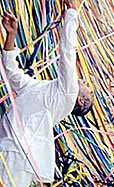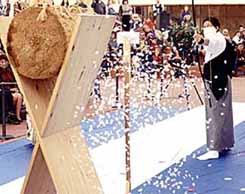|
|
|
|
|
|
"First
acts of the New Year"
Photographs
and text by Mark Vallen - January 2001
|
|
For
many Japanese, the celebration of the New Year is
one of the most important events on the calendar.
The Japanese New Year is a whole series of rituals
and observances, and unlike the one day New Year's
frivolity of the West... Oshogatsu (New Year)
is a joyful, dignified, and serious event that lasts
many days. The end of the year is a fresh start and
a time for purification, and most people begin the
celebration at the end of December with a thorough
cleaning of the house, repairing or replacing things
worn or broken. Special decorations and foods are
set out, and by January 7th the festivities come to
an end. With all of the ritual observances and celebrations
that focus on purification, longevity, prosperity,
and happiness... the one underlying emphasis is on
kotohajime (first acts of the New Year). The
first meal of the New Year, the first sunrise, the
first performance, etc., are all considered significant
events that mark a fresh beginning.
|
|
On
January 7th, the BLACK MOON attended the kotohajime
celebration sponsored by the Japanese American
Cultural & Community Center (JACCC) at their
facilities located in the historic Little Tokyo district
of Los Angeles. The event celebrating the year 2001
was curated by Artist Hirokazu Kosaka, and
consisted of a performance incorporating the martial
art of Kyudo (archery) with traditional music
and modern dance. Some 200 people gathered in the
spacious JACCC Plaza to witness the celebration.
|
|
|
|
A
space was marked off directly in front of the JACCC's
six story building using a shimenawa (Shinto sacred
rope), designating the area as holy. Musicians,
archers, and dancers then entered the area (pictured
above and at left), for the ritual of hatsuya
(the shooting of the New Year's first arrow). A troupe
of gagaku musicians sat to one side of the
performance area, and from there provided a musical
backdrop for the proceedings. Multicolored banners
and streamers were unfurled from the second story
of the JACCC building, and volunteers dropped multicolored
bits of paper that simulated a constant gentle cascade
of fluttering flower petals.
|
|
One
of the underpinnings of the performance was the solemn
observance of yet another year passing. This was beautifully
stated in the performance of a dancer who represented
the old year (pictured at right). At the beginning
of the ritual he stepped into the performance area
standing upright and with the gait of a young man,
but by the end of the affair he had transformed into
an aged, bent figure barely capable of moving at all.
The dancer's accomplished transformation was hardly
discernible as it took place incrementally and over
the course of the performance. Throughout the event
the dancer moved with slow and deliberate steps that
looked much like Tai Chi. When the ritual finally
came to a close he was the last person left in the
performance area, his movements mimicking the agonized
efforts of a body ravaged by time.
|

|
|
|
The actual focus
of the performance
was the Zen Archery ritual of hatsuya,
the shooting of the year's first arrow. The curator
of the event, Hirokazu
Kosaka, a member of
the Los Angeles Kyudo Kai, participated
as one of the archers, in fact he actually fired
the first arrow of the New Year! The
art of kyudo ("the way of the bow"),
encompasses much more than Western archery. It
incorporates Zen Buddhist philosophical principles
that harmonize the mind, body, and spirit of the
archer. While hitting the target is important,
kyudo teaches that perfect form is more
desirable than accuracy. A basic tenent of the
art is that it is better to let the arrow fly
in good form and miss one's target than it is
to have bad form and hit one's target. Kyudo is
a highly ritualized form of archery that at times
seems more like choreography than martial art.
|
|
During
the hatsuya ritual the archer aimed at a makiwara...
the traditional elevated target made of tightly bound
straw. The archer's arrow in flight symbolized the
driving away of evil spirits, and that idea was driven
home by way of a cleaver trick. Placed just in front
of the target was a stand that held a small paper
packet. When the archer let his arrow go... it first
hit the packet, which exploded into a cloud of white
paper confetti symbolizing purity. The effect was
dazzling and I consider it extremely auspicious that
I was able to capture with my camera the exact moment
of the arrow hitting it's target!
|
 |
|
|
All throughout
the ritual performance, a small group of Japanese
classical musicians performed gagaku. Gagaku
literally means "elegant music", and it's the
oldest form of orchestral music in the world.
Playing mouth organs, flutes, and drums, the orchestra
enthralled the crowd with the ethereal, mysterious,
and eerie sound of ancient Japanese court music.
Though the origins of gagaku are rooted in the
Imperial Court, today the music is publically
performed at shrines, temples, and other venues
during special occasions.
|
|
At
the conclusion of the performance a large barrel of
sake was brought out and a group of prominent individuals
including the Council General of the Japanese Embassy
in Los Angeles were invited to break open the barrel
using wooden mallets. Lovely kimono clad women distributed
hundreds of small servings of the delicious rice wine
to the expectant crowd, who finally raised their tiny
cups with a collective shout of kampai (Cheers).
JACCC
staff and volunteers tossed
beautifully wrapped bits of good luck mochi into the
crowd as free gifts were distributed to select lucky
individuals... with the BLACK MOON receiving a twenty
pound bag of rice!
|
|
 |
People
young and old made up the audience of the kotohajime
ceremony, and it was a great joy to see so many
children exposed to the cultural traditions and
ceremonies of Japan. At the end of the ritual performance
dozens of children rushed into the stage area to
play with the colorful paper streamers and flower
blossoms that had been utilized in the ritual. With
the performance concluded, everyone was invited
to enter the JACCC's Doizaki Gallery, where
a celebratory exhibition of shikishi was
offered. Shikishi
originated
in the late Heian period (794-1185)
as a canvas
for the paintings and poems of Court elites. Today
the square paper boards are used
as a surface upon which to paint congratulatory
messages, Birthday greetings, haiku poetry, or other
salutatory messages and artworks.
|
|
There
is an annual exhibit of shikishi hosted by the JACCC,
and artists, writers, priests, local personalities,
and community members are invited to create shikishi
that express thoughts of the New Year. It is always
the submitted works of the Little Tokyo community
that forms the body of the delightful exhibitions.
In summation, the kotohajimi and hatsuya rituals hosted
by the JACCC in Los Angeles are always some of the
most profoundly beautiful and moving public performances
seen on the streets of Los Angeles. They most certainly
help to usher in a happy new year for all.
|
|
|
|
This
site is owned & operated by The Black Moon
© Copyright. All rights reserved.
|
|
|
|
|